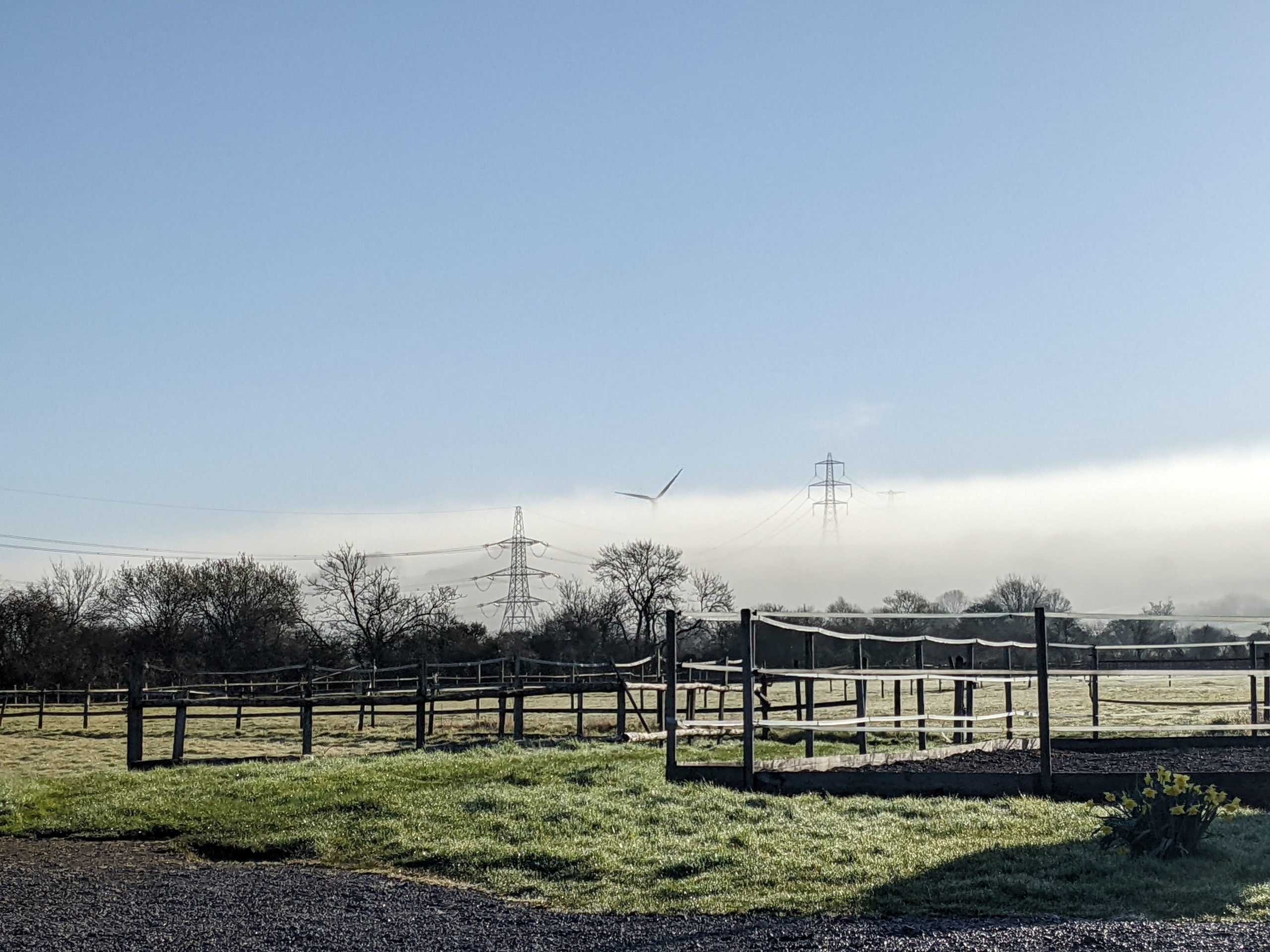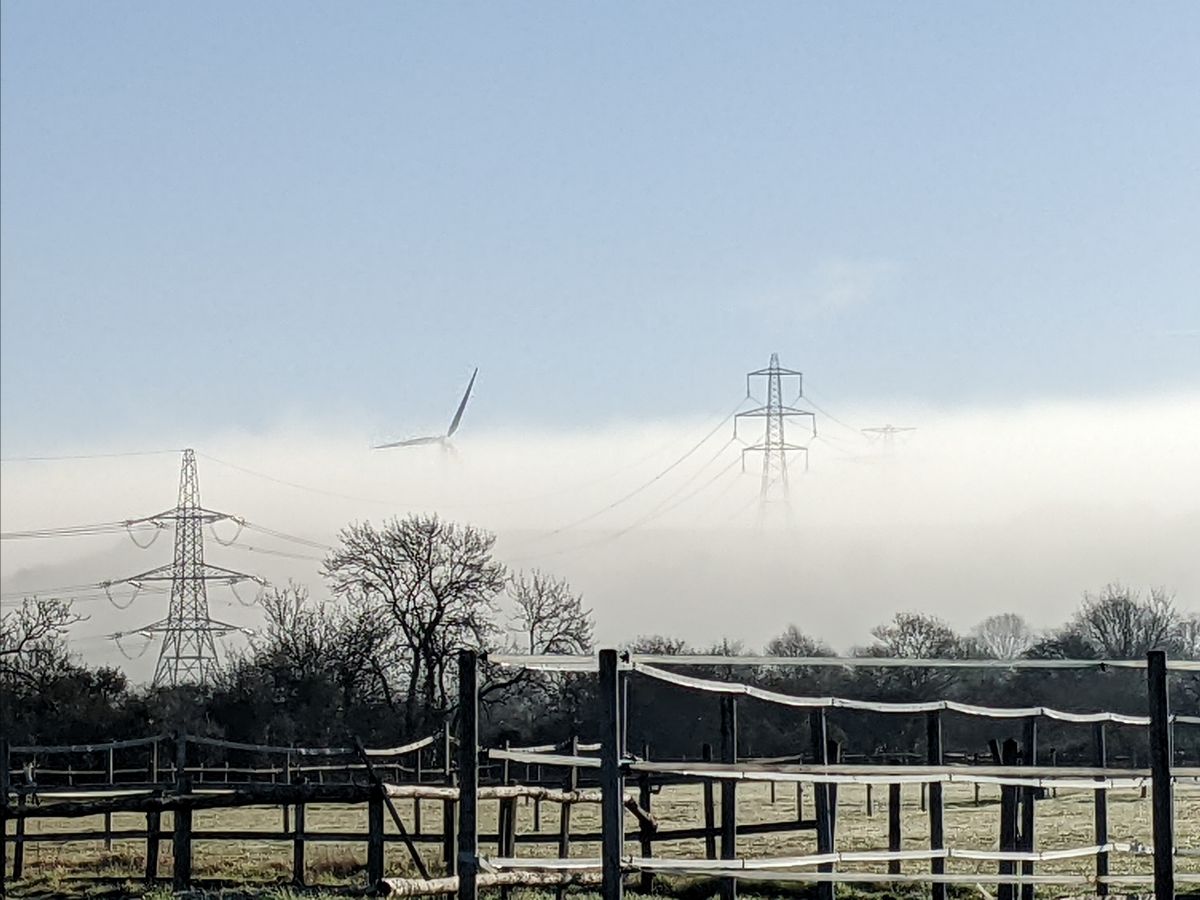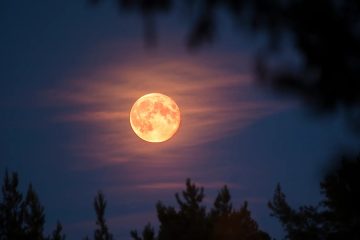Blog by Ian Wilson
A resume of local weather in the Burton area together with pointers of what to see in the night sky.
The year started quietly with January dominated, much of the month, by a large area of high pressure or anticyclone (same thing). This gave us an unusually dry month for the time of year and generally light winds, so much so, that at times all the wind turbines around Britain produced under 1% of our electricity, demonstrating their inherent weakness in needing almost 100% back-up from regular power stations operating at great cost far below their capacity. That inflates our bills.


Orographic cloud on the escarpment near Tolldown with pylons and wind turbine emerging above the layer. These clouds form when moisture-laden air meets a hillside, rises and cools causing the water vapour to condense into droplets. If such clouds become dense enough they cause orographic rain – that’s why there’s such high rainfall in mountains! Burton is 300 feet lower than Tolldown hence one degree warmer. On this occasion the warming was enough to disperse the cloud before it reached our village so Burton was cloud-free.
All changed in February with three named storms, Dudley, Eunice and Stanley. The worst to hit our area was Eunice with winds nearby probably touching 70 mph, severe by any standards but not as bad as the Burns Day Storm of January 1990 and far below the 1703 Great Storm. Eunice was a deep depression with central pressure around 960 mb (the datum is 1013 mb). For comparison the lowest recorded in the UK was 925 in 1888. Treat the claimed 122 mph gust at the Needles with caution – no other measurement came within 30 mph of that figure and local turbulence may have affected this high, exposed site which was only set up in 1996 so has no long data history for comparison.
The practice of naming storms in Britain started in 2015, an extension of the longer-running US policy of naming hurricanes, for some years using women’s names only after the allegedly (hope that word spares me being banned by our lady editors!) volatile female nature until perhaps unsurprisingly women’s pressure groups prompted a change to alternate male and female names in 1978.
When a run of storms happens like this many will say it is a sign of change that storms are becoming more frequent but the explanation is more mundane – if conditions in the Atlantic trigger one storm they will very likely remain the same long enough to set off a few more.
Surprising statistic – the number of global hurricanes in 2021 (37) was the lowest since satellite recording began in 1980.
In the night sky, for early risers Venus shines brightly low above the south-eastern horizon, possibly too low to be seen from some properties in Burton. Mars is a little above it but much fainter
Mercury is elusive to see as it is so close to the sun it appears above the horizon for just a short time but may be seen above the western horizon just after dusk in the middle of the month.
A meteor shower, the Lyrids, is due peaking on the 22nd and 23rd, predicted at around 20 meteors an hour – worth a look but sometimes these displays can be disappointing.
For younger – and not-so-young – readers
Do you know how to spot the Pole Star, used by sailors long ago to tell them which way was north?
Go outside after dark on a cloudless evening when there isn’t much moon and look to the north (towards the motorway). Spot the group of seven bright stars called The Plough because they look like an old-fashioned horse plough. At this time of year it is at high elevation and turned on its end. It’s also called the Great Bear (but it doesn’t look much like a bear, does it?) or in Latin Ursa Major. Just to add confusion the Americans call it The Big Dipper so that’s four names for one constellation! Now follow an imaginary line outwards from the handle and the brightest star along that line is the Pole Star or Polaris. It is due north from anywhere in the Northern Hemisphere. Perhaps one day if you are ever lost at night it might help you find the way home.

0 Comments